Magnetic field
The Magnetic field is a force which is generated due to energy change in a volume of space. A magnetic field is produced by an electrical charge in motion e.g. current flowing in a conductor, orbital movement and spin of electrons. The magnetic field can be described by imaginary lines as shown in the figure below for a magnet and a current loop.
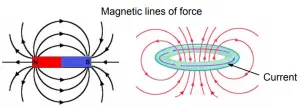
1. Permeability
It is defined as the ratio of magnetic flux density and magnetic field intensity.
μ = B/H
where B = magnetic flux density (Wb/m2)
H = magnetic field intensity (A/m)
μ = μoμr
where
μo = 4π × 10-7 H/m
μr = relative permeability
μo = permeability in free space
2. Magnetic Dipole and Monopole
Analogous to electric dipole, a magnetic dipole can be defined as two monopoles of opposite and equal strength
separated by a certain distance.
A magnetic monopole, however, is not observed in nature.
3. Magnetic Dipole Moment
A current loop constitutes a magnetic dipole. The magnetic dipole moment is defined as the product of the area of loop and current through the loop.
It is a vector quantity and its direction is normal to the plane containing a current loop.
4. Magnetic moment
The magnetic moment of a magnet is a quantity that determines the torque it will experience in an external magnetic field. A loop of electric current, a bar magnet, an electron, a molecule, and a planet all have magnetic moments.
- Being a moving charge, electrons produce a small magnetic field having a magnetic moment along the axis of rotation.
- The spin of electrons also produces a magnetic moment along the spin axis.
- Magnetism in a material arises due to the alignment of magnetic moments.
5. Magnetization
With the application of a magnetic field, magnetic moments in a material tend to align and thus increase the magnitude of the field strength. This increase is given by the parameter called magnetization, M, such that
B = μoH + μoM
M = χmH
χm is called magnetic susceptibility
χm = μr – 1
6. Types of Magnetism
Depending on the existence and alignment of magnetic moments with or without application of magnetic field, three
types of magnetism can be defined.
- Diamagnetism
- Paramagnetism
- Ferromagnetism
(i) Diamagnetism
- Diamagnetism is a weak form of magnetism which arises only when an external field is applied.
- It arises due to change in the orbital motion of electrons on the application of a magnetic field.
- There are no magnetic dipoles in the absence of a magnetic field and when a magnetic field is applied the dipole moments are aligned opposite to field direction.
- The magnetic susceptibility, χm or (μr – 1) is negative i.e. B in a diamagnetic material is less than that of vacuum.
- Diamagnetic materials: Al2O3, Cu, Au, Si, Zn.
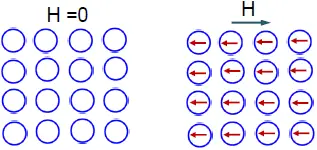
(ii) Paramagnetism
- In a paramagnetic material, the cancellation of magnetic moments between electron pairs is incomplete and hence magnetic moments exist without any external magnetic field.
- However, the magnetic moments are randomly aligned and hence no net magnetization without any external field.
- When a magnetic field is applied all the dipole moments are aligned in the direction of the field.
- The magnetic susceptibility is small but positive. i.e. B in a paramagnetic material is slightly greater than that of vacuum.
- Paramagnetic materials: Al, Cr, Mo, Ti, Zr.
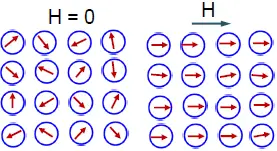
(iii) Ferromagnetism
- Certain materials possess permanent magnetic moments in the absence of an external magnetic field. This is known as ferromagnetism.
- Permanent magnetic moments in ferromagnetic materials arise due to uncancelled electron spins by virtue of their electron structure.
- The coupling interactions of electron spins of adjacent atoms cause alignment of moments with one another.
- The origin of this coupling is attributed to the electron structure. Ferromagnetic materials like Fe (26 – [Ar] 4s23d6) have incompletely filled d orbitals and hence unpaired electron spins.
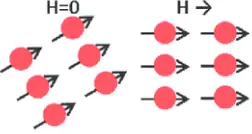
(iv) Antiferromagnetism
- If the coupling of electron spins results in anti-parallel alignment then spins will cancel each other and no net magnetic moment will arise.
- This is known as antiferromagnetism. MnO is one such example.
- In MnO, O2- ions have no net magnetic moments and the spin moments of Mn2+ ions are aligned anti-parallel to each other in adjacent atoms.

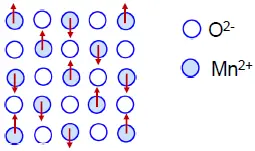
(v) Ferrimagnetism
- Certain ionic solids having a general formula MFe2O4, where M is any metal, show permanent magnetism, termed ferrimagnetism, due to the partial cancellation of spin moments.
- In Fe3O4, Fe ions can exist in both 2+ and 3+ states as Fe2+O2– (Fe3+)2(O2-)3 in 1:2 ratio.
- The antiparallel coupling between Fe3+ (Half in A sites and a half in B) moments cancels each other.
- Fe2+ moments are aligned in the same direction and result in a net magnetic moment.

7. Domains
- Ferromagnetic materials exhibit small-volume regions in which magnetic moments are aligned in the same directions. These regions are called domains.
- Adjacent domains are separated by domain boundaries. The direction of magnetization changes across the boundaries.
- The magnitude of magnetization in the material is the vector sum of magnetization of all the domains.
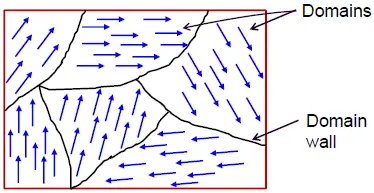
8. Magnetization and Saturation
When a magnetic field is applied to a ferromagnetic material, domains tend to align in the direction of the field by domain boundary movement and hence, the flux density or magnetization increases.
As the field strength increases domains which are favorably oriented to field direction grow at the expense of the unfavorably oriented ones. All the domains are aligned to the field direction at high field strengths and the material reaches the saturation magnetization, Ms.
The initial slope of the B-H or M-H curve at H =0 is called initial permeability, μi, which is a material property.
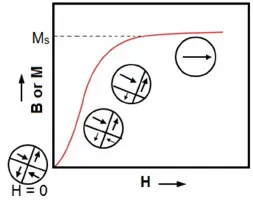
9. Hysteresis loop
If the field is reduced from saturation by magnetic reversal, a hysteresis develops.
As the field is reversed the favorably oriented domains tend to align in the new direction. When H reaches zero some of the domains still remain aligned in the previous direction giving rise to a residual magnetization called remanence, Mr.
Hc, the reverse field strength at which magnetization is zero, is called Coercivity.
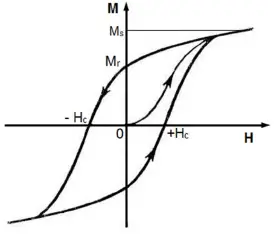
10. Hard and Soft magnets
Based on their hysteresis characteristics ferromagnetic and ferrimagnetic materials can be classified as hard and soft magnets. You can read about Hard and Soft magnets here.
